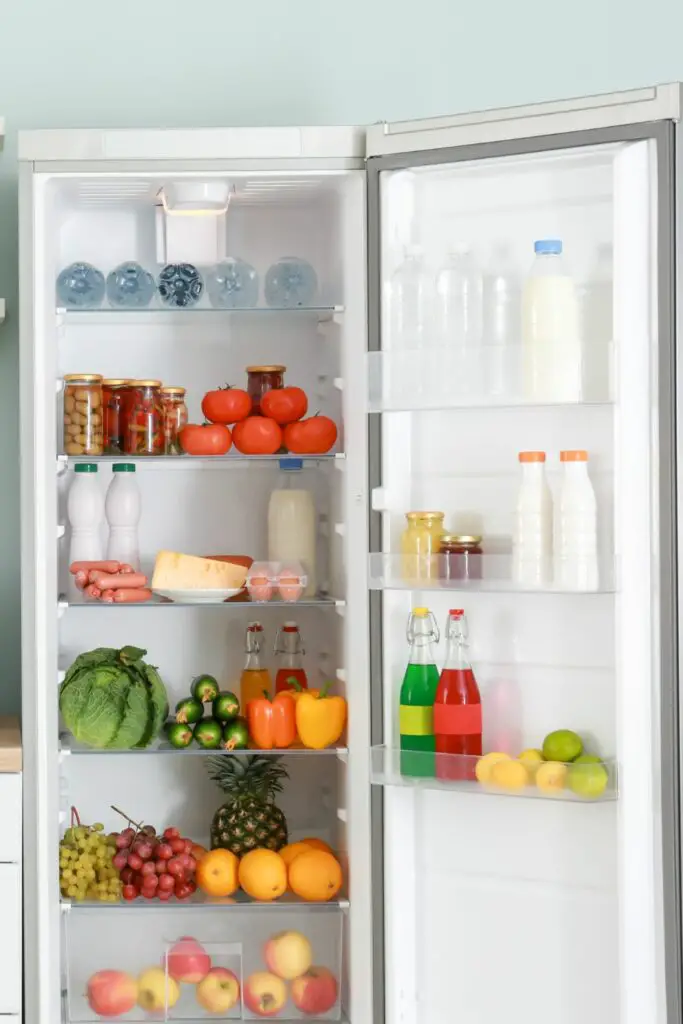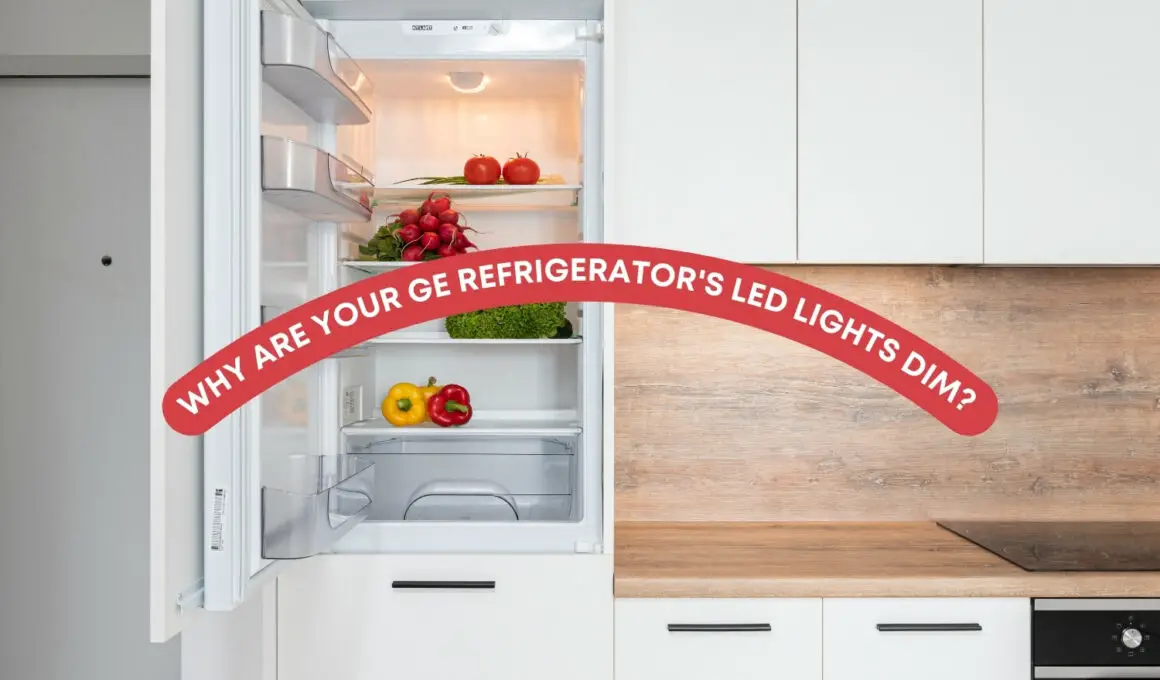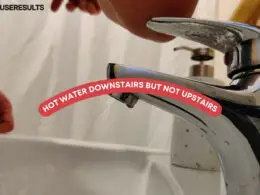Table of Contents Show
Welcome to our practical guide on tackling the frustrating issue of dim LED lights in your GE refrigerator. If you’ve ever reached for a midnight snack only to find your fridge casting a faint glow, you know how essential bright, functional lighting is.
I’m here, leveraging years of hands-on experience in home projects and a track record of client satisfaction, to shine a light on why your refrigerator may not be as luminous as it should be.
Understanding why these LED lights lose their brilliance is more than a matter of convenience; it’s about ensuring your appliance operates efficiently and safely. We’ll explore the common culprits behind this dimming dilemma and provide clear, actionable solutions to brighten up your refrigerator once again.
So let’s get straight to the point and illuminate the causes and fixes for dim LED lights in your GE refrigerator, ensuring you won’t have to navigate your late-night kitchen expeditions in the semi-darkness.
Understanding Your GE Refrigerator’s LED Lighting System

1. Overview of LED Technology in Refrigerators
LED lighting has revolutionized the way we light up our homes, and this includes the modern refrigerator. Unlike their incandescent predecessors, LEDs operate with efficiency and longevity, emitting light in a specific direction, which makes them particularly suitable for confined spaces in a refrigerator.
2. Benefits of LED Lights over Traditional Bulbs
The transition to LEDs in refrigeration has brought about several key benefits. For starters, they consume significantly less power – some estimates suggest up to 80-90% less than traditional bulbs – leading to energy savings.
Additionally, LEDs have a much longer lifespan, reducing the frequency of replacements. They also produce less heat, which is particularly advantageous in a refrigerator as it helps to maintain consistent temperatures without overworking the cooling system.
3. Explanation of How GE Integrates LED Lighting in Their Models
According to a study published in the “Energy Efficiency” journal, the integration of LED lighting in household appliances has been a move towards not only improved energy efficiency but also enhanced user experience.
GE has adopted this innovation, embedding LED lighting in their refrigerators to provide bright, uniform lighting that improves visibility without compromising on energy consumption.
They’ve strategically placed these lights to offer optimal illumination, thereby elevating the functionality and aesthetics of their refrigeration units. By adopting LED technology, GE ensures that their refrigerators meet modern standards for efficiency and design, catering to the practical and eco-conscious consumer.
Common Causes of Dim LED Lights in GE Refrigerators
When the LED lights in your GE refrigerator dim, it’s not just a nuisance; it’s a symptom of an underlying issue that can range from the simple to the complex. Here’s what could be dimming the light in your fridge:
1. Electrical Issues
- Faulty LED Driver: The LED driver is crucial as it regulates the power of the lights. When it fails, it can’t maintain the required voltage, causing the lights to dim.
- Compromised Wiring: Wiring issues within the refrigerator can lead to poor electrical connections and result in dim lighting. Over time, wires can become loose or corroded.
- Malfunctioning Control Board: The control board is the brain of the refrigerator, and if it’s not functioning properly, it might not send the correct signals to the LED lights, leading to dimming or flickering.
2. LED Light Failure
- Individual LED Malfunction: Not all LEDs go out at once. If one or more individual LEDs fail, the overall lighting in the fridge can appear dimmer than usual.
- LED Lifespan and Degradation: LEDs are known for their longevity, but they don’t last forever. Over time, they can degrade and emit less light, leading to a dim appearance.
3. Power Supply Problems
- Inconsistent Power Source: If your refrigerator isn’t receiving consistent power due to issues with your home’s electrical supply, the LEDs may not perform optimally.
- Voltage Fluctuations: Surges or dips in your home’s voltage can affect the performance of your refrigerator’s LEDs, causing them to dim or flicker.
4. Environmental Factors
- Excessive Moisture: Refrigerators handle a lot of moisture, and if there’s too much, it can affect the electrical components, including those that power the LED lights.
- High Ambient Temperatures Affecting Performance: The area around your refrigerator should be kept at a recommended temperature. If it’s too warm, the refrigerator has to work harder to stay cool, which can sometimes affect the LED lights.
Recognizing the signs early on and identifying the cause is crucial. Each of these issues can be addressed with specific fixes, which can restore your refrigerator’s lighting to its full functionality, ensuring your late-night snacks are never again shrouded in darkness.
Troubleshooting Dim LED Lights in Your GE Refrigerator
Before calling in a professional or diving into more intricate diagnostics, there are a few preliminary steps any homeowner can take. These initial actions can often resolve the issue without further complexity.
1. Preliminary Checks
Power Cycle the Refrigerator
Sometimes, the simplest solution is to reset the system. Unplug your refrigerator for about a minute and then plug it back in. This can reset the electronic controls and potentially restore full brightness to your LED lights.
Inspect for Obvious Signs of Damage or Moisture
Take a look around and inside your refrigerator for any visible signs of damage to the LED units or wiring. Also, check for excess moisture which could be a sign of a larger issue that’s affecting the electrical components.
2. Testing the LED System
Once you’ve performed the initial checks, and if the lights are still dim, it’s time to test the LED system more thoroughly. Always ensure your safety first by unplugging the refrigerator before inspecting any electrical components.
How to Safely Test LED Drivers
LED drivers convert your home’s power supply to a lower voltage than LED lights require. To test them, you’ll need a multimeter. With the refrigerator unplugged, locate the LED driver, which is typically behind the light panel.
Use the multimeter to check the output voltage according to the specifications in your refrigerator’s service manual. If the readings don’t match, the driver may need replacing.
Assessing Control Board Functionality
The control board can be a bit more challenging to test, as it requires a bit of technical knowledge. If you’re comfortable, you can check for any burnt or damaged components on the board, or use a multimeter to verify that the board is receiving and sending out the correct voltages. If you’re not sure what you’re looking for, it may be time to call a technician.
By following these steps, you can often pinpoint the issue causing your GE refrigerator’s LED lights to dim. If these measures don’t shed light on the problem, it could be time to consult with a professional who can offer a more in-depth diagnosis and solution.
Step-by-Step Fixes for Dim LED Lights
When your refrigerator’s LED lights are dim, and you’ve performed your preliminary checks, there are several steps you can take to attempt a fix. Here’s how to approach the problem, with safety as the top priority.
1. DIY Fixes
Resetting the Refrigerator’s Power
As previously mentioned, begin with a simple power cycle. Unplug your fridge, wait a minute, and plug it back in. This can reset the system and may resolve the lighting issue.
Replacing Individual LEDs or LED Strips
If you’ve identified that only some LEDs are dim or out, they might need replacing. First, ensure your fridge is unplugged. Then, remove the housing cover or the light assembly according to your GE refrigerator model’s manual.
Replace the individual LEDs or the entire strip if necessary, being careful to handle any electronic components gently.
Addressing Minor Wiring Issues
If you’ve noticed loose or disconnected wires during your inspection, you might be able to fix these yourself. After unplugging the fridge, reconnect or tighten the wiring, ensuring no bare wires are touching each other or the fridge’s body. If wires appear corroded or damaged, they’ll need replacing.
2. When to Call a Professional
Electrical Component Replacement
If you’re not experienced with electrical work, replacing components like the LED driver or control board should be left to a professional. They have the expertise to handle these parts without causing further damage.
Diagnosing Complex Electrical Faults
If the fixes above haven’t worked and you suspect a more complex issue, it’s wise to call in a technician. They can perform a thorough diagnostic and identify problems that aren’t immediately obvious to the average homeowner.
Warranty Considerations
Before undertaking any repairs, check the warranty on your GE refrigerator. Some repairs may require professional service to keep the warranty valid. Plus, if your fridge is still under warranty, the repair might be covered at no extra cost to you.
By tackling what you can at home and knowing when to bring in a professional, you’ll extend the life of your refrigerator and ensure it functions at its best. Proper lighting isn’t just about visibility—it’s about making your appliance work efficiently and keeping your food safe.

Preventing Future LED Light Issues in Your GE Refrigerator
Maintaining your refrigerator’s LED lights isn’t just about addressing problems as they arise; it’s also about taking proactive steps to prevent issues from occurring in the first place. Here’s how you can keep the lights bright and your refrigerator in top condition.
1. Proper Maintenance Tips
- Ensure Good Ventilation: Always leave enough space around your refrigerator to allow for proper air circulation. Overheating can affect electronic components and potentially lead to LED light failure.
- Gentle Usage: Avoid slamming doors or rough handling of shelves and drawers, as vibrations can loosen LED fittings and wiring over time.
- Surge Protection: Consider using a surge protector to shield your refrigerator from voltage spikes which can damage the LED driver and other sensitive electronic components.
2. Regular Cleaning Schedule
- Dust and Debris Clearance: Keep the refrigerator coils clean from dust and pet hair, as accumulated debris can cause the fridge to work harder, which may indirectly affect the LED lights.
- Interior Cleaning: Regularly wipe down the inside of your fridge, including light covers, to ensure the LED lights can shine through clearly and are not dimmed by residue or buildup.
3. Monitoring Refrigerator Performance
- Keep an Eye on Temperature Readings: If your fridge appears to be running too warm or too cold, it might indicate a problem that could eventually affect your LED lights.
- Listen for Unusual Noises: Unusual sounds coming from your fridge can be the first clue to potential issues with the appliance that could lead to a range of problems, including those with the lighting system.
- Energy Consumption Tracking: Sudden increases in your energy bill can be a sign of an inefficient refrigerator, which might also mean overworked electrical components including LEDs.
By regularly maintaining, cleaning, and monitoring the performance of your GE refrigerator, you can greatly reduce the chances of facing dim LED lights and ensure that the heart of your kitchen remains bright and reliable.
This routine care not only keeps your refrigerator in optimal condition but also heads off inconvenient and potentially costly repairs down the road.













